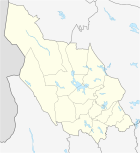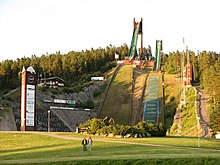Falun
| Falun | ||||
|
||||
| State : | Sweden | |||
| Province (län): | Dalarna County | |||
| Historical Province (landskap): | Dalarna | |||
| Municipality : | Falun | |||
| Coordinates : | 60 ° 36 ′ N , 15 ° 38 ′ E | |||
| SCB code : | 6504 | |||
| Status: | Crime scene | |||
| Residents : | 37,000 (December 31, 2015) | |||
| Area : | 25.16 km² | |||
| Population density : | 1471 inhabitants / km² | |||
| Falun västra | ||||
|---|---|---|---|---|
| Coordinates : | 60 ° 36 ' N , 15 ° 34' E | |||
| SCB code : | 6458 | |||
| Status: | Crime scene | |||
| Residents : | 988 (December 31, 2015) | |||
| Area : | 1.73 km² | |||
| Population density : | 571 inhabitants / km² | |||
| List of perpetrators in Dalarna County | ||||

Falun (formerly Fahlun, Swedish [ˈfɑːˈlɵnː] ) is a city in the Swedish province of Dalarnas län and the historical province (landskap) Dalarna . The city is the capital of the municipality of the same name and the seat of the provincial administration of Dalarna County.
Falun is famous for its mines, which, together with the working-class districts and the industrial landscape of Kopparbergslagen, are part of the UNESCO World Heritage List .
history
The city developed in the course of copper mining , which is proven from the 11th century on Tiskasjöberg . Mining was initially done by farmers. In the 14th century, markets were regularly held on the lower reaches of the Faluån River and a small settlement developed around the market square.
With the increasing importance of the mine, the settlement grew and in 1641 Falun received city rights. At that time, Falun was one of the largest cities in Sweden with a population of around 6,000. The copper mines in Falun then accounted for about two thirds of world production. The mining was haphazard, and in 1687 a large part of the mine collapsed. This also signaled the end of the heyday and the mine began to decline. One of the mining accidents in the calendar story Unexpected Reunion by Johann Peter Hebel and in the story Die Bergwerke zu Falun by ETA Hoffmann is processed in literature .
In 1761 two fires destroyed around two thirds of the city, which was built almost entirely of wood. During the reconstruction, the most important buildings were built from stone or slag. But the population decreased continuously and around 1850 the city only had 4,000 inhabitants.
The construction of the railroad brought a new boom for Falun. Falun was the railway line Orsa-Falun , the railway line Falun-Gävle and the Bergslagernas Järnvägar to Gothenburg connected, factories settled in the city. In the 20th century the city developed into an administrative and school center, while traditional mining came to an end. In 1992 the last mine was closed.
In the middle of the 20th century, the center of the city was largely redesigned, but some public representative buildings (such as Bergslagkontoret, City Hall, Kronobranneriet, Landshövdingsresidenset and Kopparvågen) were preserved. Together with three working-class neighborhoods from the 17th century that were not victims of the great fire, the industrial landscape around the mine and the cultural landscape of the miners in the area, they have been a World Heritage Site since 2001.
In the course of the last few decades, Falun has grown together with the surrounding villages, especially with the adjoining Korsnäs and Hosjö to the east , as a result of which the city now extends along the entire northern shore of Lake Runn . In 2015, on the other hand, a district west of the center on the north bank of Lake Stora Vällan was spun off from Statistiska centralbyrån as an independent crime scene Falun västra ('Falun West').
economy
Today, Falun is primarily a service center. In addition to the local government, Falun also houses the provincial government and the provincial council administration . There are also some institutes at Dalarna University in Falun. Tourism is also an important industry. The main attractions are the town and the mine, the Lugnet ski jumping center and nearby Sundborn , which is home to the painter Carl Larsson .
Sports
Falun is the center for national and international winter sports competitions. Falun is home to the Swedish Ski Association and the Lugnet sports and leisure area, which not only has the Lugnet ski jumps but also extensive cross-country ski trails and downhill slopes. Competitions in the Ski Jumping Continental Cup and the Nordic Combined World Cup were held on the jumps until 2002 . Since 2002, however, Falun has only been the venue for the FIS Cup and Ski Jumping Continental Cup as well as for world cup races in cross-country skiing.
Falun hosted the Nordic World Ski Championships in 1954 , 1974 , 1993 and 2015 . In 1980 , a non-Olympic competition was also held in Falun. However, the city has already been defeated twice in candidacies for the Winter Olympics . In 1988 they lost to Calgary and 1992 to Albertville .
In ice hockey, Falun wore the A-Junior World Championship together with Gävle in 1980 . At the 1986 Biathlon World Championships , Falun hosted the women's competitions.
In addition to winter sports, there are also water sports in Falun, due to the many lakes in the area. In motorboat racing , in addition to the Swedish championships between 1968 and 1992, there was once a European title and three times a world title. German drivers were successful twice. In 2012 the area around Falun and the city park hosted the European orienteering championships .
Falun is also known by its Bandymannschaft of Falu BS , who played for many years in the highest league in the country.
The city also has a floorball team , the IBF Falun , which won the Swedish championship title and the Champions Cup title three times in a row between 2013 and 2015 , the highest honor in club hockey.
sons and daughters of the town
- Jan Håkan Åberg (1916–2012), church musician and composer
- David Andersson (* 1981), orienteer
- Lars Ardelius (1926–2012), writer
- Andreas Arén (* 1985), ski jumper
- Ferdinand Boberg (1860–1946), architect
- Adam Boqvist (* 2000), ice hockey player
- Jesper Boqvist (* 1998), ice hockey player
- Joakim Brodén (* 1980), Swedish-Czech metal singer and musician
- Patrik Carlgren (* 1992), football player
- Mattis Cederberg (* 1971), jazz musician
- Björn Dixgård (* 1981), musician
- Mattias Ekström (* 1978), racing car driver
- Johan Eriksson (* 1985), ski jumper
- Ludwig Frankmar (* 1960), baroque cellist
- Mats Gren (* 1963), soccer player and coach
- Tomas Jonsson (* 1960), ice hockey player
- Jenny Kallur (* 1981), athlete
- Susanna Kallur (* 1981), track and field athlete
- Lina Leandersson (* 1995), actress
- Marcus Ljungqvist (* 1974), racing cyclist
- Jenny Rissveds (* 1994), racing cyclist
- Gunnar Säve-Söderbergh (1910–1948), paleontologist and geologist
- Lars-Erik Sjöberg (1944–1987), ice hockey player and scout
- Rikard Sundén (* 1980), guitarist and music producer
- Pär Sundström (* 1981), bass player and manager
- Carl Westman (1866-1936), architect
- Members of the band Sabaton , power metal band
- Members of the band In Mourning , progressive death metal band
- Members of the band Twilight Force , power metal band
Town twinning
Town twinning exists with Hamina in Finland, with Røros in Norway, with Vordingborg in Denmark, with Gütersloh in Germany and with Grudziądz in Poland.
See also
Web links
- Official website of the municipality (German, English, French, Swedish)










